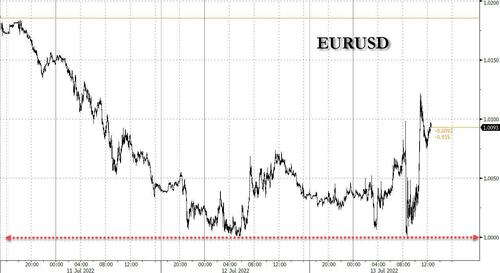Euro Parity: Barriers And Psychology
By Elwin de Groot, Rabobank head of macro strategy
The big theme in markets yesterday of course was the Eurodollar and the question whether it did or did not fall to/below parity, a level considered by many as a ‘psychological barrier’. According to my terminal the currency pair did touch the 1 level against the dollar during yesterday’s trading session, but traders have been telling us that it actually never really touched it (looking at the fifth(!) decimal place), before bouncing off and stabilising at around 1.004 early this morning.
If one would consider the parity level to be a real psychological barrier, the traders’ view makes sense. One explanation is that potential buyers would not be very eager to buy at exactly that level because once the pair falls to 1 there are no buyers until it has sunk considerably below it. Similarly, potential sellers may be reluctant to sell at the psychological barrier for fears that any sharp dip below it would immediately trigger large demand orders which could, in turn, lead to a sharp reversal.
I am doubtful that we should read much more into this than this parity barrier simply being a technical market quirk rather than a fundamental factor, but the bounce-off that we saw yesterday really is a thing of beauty in itself when you look at the tick chart. Personally I would not draw any strong conclusions from yesterday’s market moves about the future trajectory of the currency pair. It reminds me of an occasion many years ago (although this is distinctly different) where a technical analyst pointed out to me – looking at the chart of a certain stock – that the stock would “unlikely fall through a key psychological barrier of 100” because it had not done so during several episodes in the past years. It looked plausible, until I realised that the stock had, not so long before, been split in a 2.5:1 ratio… Of course, the EUR isn’t subject to stock splits, but its fundamentals may be distinctly different amidst the current geopolitical and energy crises and our fundamental view is that is should ultimately recover.
That said, the fact that there is so much attention for this also drives home the message how important a role psychology plays in our day-to-day lives and thus in our economy and markets (and how little most economic models take this into account). Clearly, hope and fear should not be dismissed as factors ultimately driving actions of both households and businesses.
A case in point is yesterday’s ZEW survey in Germany. Investor sentiment hit its lowest level since the Eurozone’s debt crisis in 2011. The headline expectations index fell by a whopping 25.8 points to -53.8; one would almost think that is also a psychological barrier as it stood at exactly -53.8 in December 2011. But quickly forget that, because in November it stood at -55.2 (and it’s pretty silly to think of psychological barriers when you are looking at some aggregate of a questionnaire where the individual contributors – in contrast to a trading venue – probably don’t take into account what others might be filling out).
In any case, the list of reasons for such pessimism reflected in the ZEW survey is long. Clearly, concerns over a potential lack of gas played a significant role in the survey as it was held just as German economy minister Habeck warned of “Lehman-like” risks should the flow of gas come to a standstill. Meanwhile, the ECB pre-announced rate hikes for July and September last month. The sharpest fall in ZEW sentiment, unsurprisingly, therefore was in the utilities sector, followed by banks, chemicals, electronics and retail. But other surveys also indicate that many German industries are still struggling with considerable material shortages and lack of personnel. As such, the recent fall in the euro is not primarily seen as a boon to exporters (who are still facing backlogs and shortages), but more as an amplifier of high import prices.
The question, now, is whether we should read more into this latest survey about the psychological state of investors and their concerns about the German economy? After all, troughs in the survey often have coincided with troughs in the equity market, so any ‘glass half full’ type of person could argue that we should “buy the dip” as it cannot get much worse than this, right? Or remember the ‘millennium bug’ in 1999? It was feared at the time that the switchover to the new millennium would unleash mayhem because many computers’ date settings would fail. It never really came to pass.
However, I would argue that this time is different and the bigger risk is that self-fulfilling prophesies speed up the economic slowdown in the months ahead. For one, the risk of a lack of supplies is real, not some sort of software issue that can be patched. Secondly, whilst “fear” is often considered a “bad counsellor”, it would seem that those fears are now actually giving way to the Germans losing hope, which itself is potentially more concerning as it may affect future investment behaviour. To back this up, I did a Google trends lookup of the search words of “Angst” and “Furcht”, which shows no discernible trend in Germany over the last 6 months or so. If anything both are below the levels seen during the pandemic, when fears were also riding high.
However, using the search term “Hoffnung” paints an entirely different picture: the number of searches including the term hope has fallen to the lowest level since Google’s records began. It may well have more profound implications as we head into the summer lull.
Tyler Durden
Wed, 07/13/2022 – 15:20
via ZeroHedge News https://ift.tt/MpKkIVh Tyler Durden
